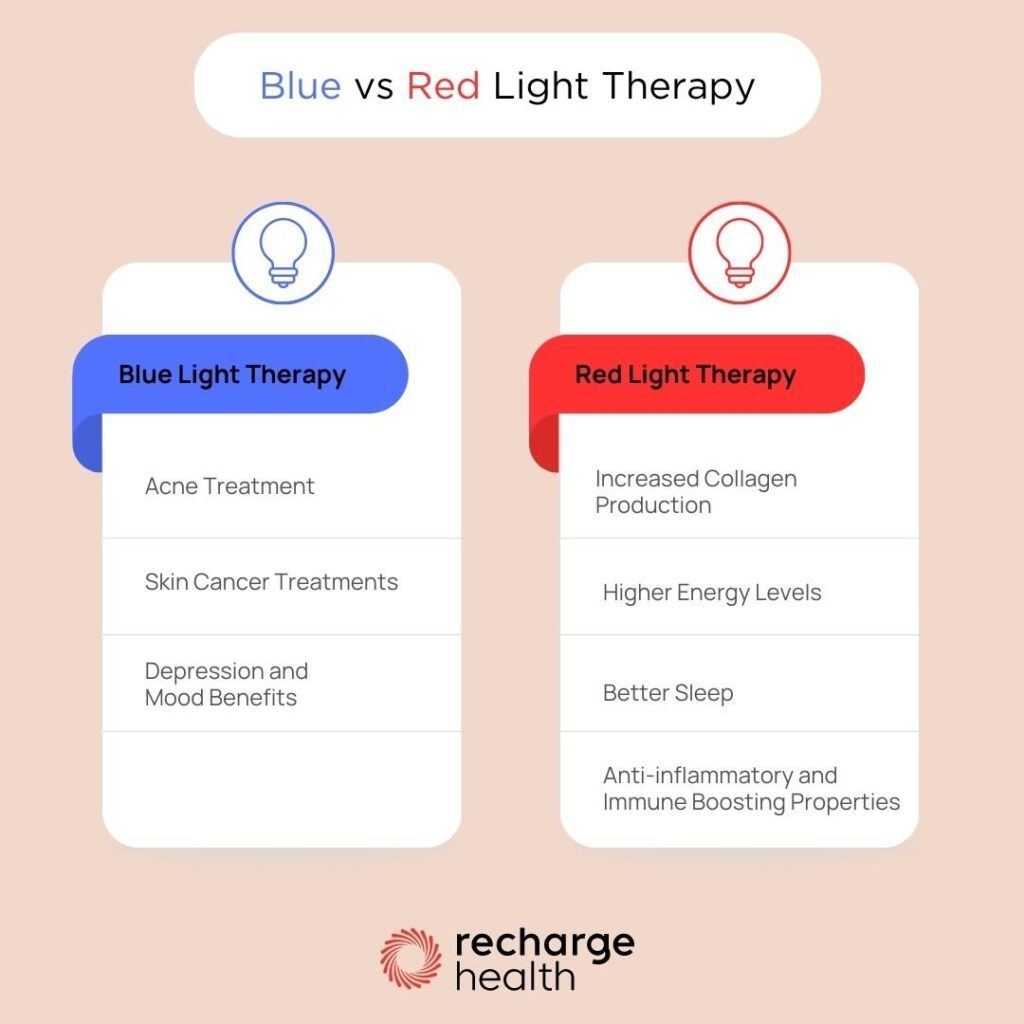Red Light vs Blue Light Therapy: Which Treatments to Choose?


Thanks to the advancement of light technology, photobiomodulation or LED therapy is well established as the treatment of choice for many conditions. However, you might be wondering which type of LED therapy is right for you.

How Does Light Therapy Work?
Photobiomodulation or light therapy is a form of treatment which uses LED emitting diodes to dispense light of different wavelengths. Led light therapy is not to be confused with lasers, and it does not cause skin damage.
Nowadays, most LED light therapy devices use either red and near infrared (NIR) light, or blue light. The wavelengths of light used in both of these types of LED light therapy emulate the natural frequencies of sunlight.
Red and near infrared light frequencies used for red LED light therapy are the same as the light we get from the sun early in the morning and at dusk. Blue light frequencies are prevalent during the middle parts of the day.
Photobiomodulation, or low level laser therapy originated with NASA in the 1980s. The space agency used red light in plant growth experiments and discovered that not only does it boost plant growth, red light stimulates wound healing in people as well.
Red and blue light from a light therapy device penetrate the skin and tissues at different depths, depending on the wavelength of the light. Inside the skin and the tissues, the photons from the light cause photochemical and photophysical changes in the cells, and sometimes even on a molecular level.
What Is Blue Light Therapy Good For?
Blue light therapy is most commonly used to treat various skin conditions and concerns.
Treatment of Mild and Moderate Acne
When it comes to cosmetic uses, blue light is the most effective when it comes to treating acne caused by bacteria. The bacteria not only cause inflammation, but also promote oil production, which leads to clogging of skin’s pores.
This type of bacteria is naturally sensitive to blue light frequencies. Blue light kills bacteria by destroying their outer walls. Eliminating the bacteria often eliminates the skin’s propensity to form acne.
Skin Cancer Treatments
One of the most important uses of blue light therapy is for treatment of skin cancer, and pre-cancerous spots. These spots are caused by sun damage and with time they might develop into skin cancer.
Photo bio modulation with blue light works together with medication to treat the affected area. The light in combination with the medication causes flaking of the affected skin. After treatment, the patient is left with healthy, younger looking skin.
Depression and Mood Benefits
During the fall and winter, many people are affected by seasonal affective disorder, a type of mood disorder similar to depression. This especially happens in colder climates, where there is naturally less daylight during the colder months. Light therapy and vitamin D supplements are among the most effective treatments for seasonal affective disorder.
What Is Red Light Therapy Good for?
Red light therapy has numerous health benefits.
Increased Collagen Production
Red light therapy acts as a boost when it comes to both cell proliferation and collagen production. Most treatments used to increase collagen production, like microdermabrasion, tend to be invasive. Unlike them, red light therapy causes no tissue damage.
Red light therapy is proven to measurably increase collagen density in blinded, controlled clinical trials. This results in a more youthful appearance of the skin, reducing wrinkles and fine lines, and tightening of the skin’s pores.
Higher Energy Levels
One of the most important effects of red light happens on a cellular level. In each of the cells, it penetrates, red light supports and boosts the proliferation of the mitochondria. The mitochondria are the part of the cell that produces cellular energy and oxygen needed for the tissue to thrive.
Red light allows the body to produce more energy by providing mitochondrial support.

Better Sleep
Because the sun emits red light as it goes down, our brains are trained to respond to red light by secreting the sleep hormone melatonin. Melatonin regulates the body’s circadian rhythm, the natural pattern of sleep and wake cycles. Blue light easily disrupts these cycles, which naturally occurs during middle parts of the day.
However, the screens that people use nowadays also emit large quantities of blue light, which interruptsmelatonin secretion.
Red light therapy, especially if applied in the evening, can help restore this natural rhythm, positively affecting sleep disorders, such as insomnia.
Anti-inflammatory and Immune Boosting Properties
Red light therapy supports the immune system and helps distribute protective immune cells to affected tissue through improved blood circulation. It also helps decrease inflammation in the tissue and supports better tissue drainage, which lowers swelling. This leads to faster healing times and faster natural cell regeneration.
Is Blue Light Therapy Safe?
You have probably heard about different blue light blocking methods, so it’s interesting to see that there is blue light therapy. However, even thought too much blue light can be harmful, careful dosing can have many benefits.
Blue light therapy is mostly safe. However, it can have some adverse effects on people who have especially sensitive skin or who suffer from photosensitivity disorders.
In general, blue light therapy doesn’t have many side effects when you use it as an acne treatment or to treat other skin care concerns.
Blue light therapy with at home devices can be a safe part of your regular skincare regimen. It does not employ UV rays and poses no risk when it comes to skin cancer.
Blue wavelengths can, however, cause some irritation and redness. Also, as with the use of any form of light therapy which uses bright lights, it is necessary to wear eye protection during blue LED light treatments.
Is Red Light Therapy Safe?
Red light therapy is one of the safest forms of light therapy. The light emitting diode does not produce heat when it’s emitting red and near infrared light wavelengths. It also doesn’t emit any ultraviolet rays.
This means that there is no damage to the skin cells. Red LED light doesn’t cause burns, redness or irritation in the treatment area and it does not increase your chances of getting skin cancer.
The only precaution necessary when using a red light therapy device is the same as with any other LED light therapy treatment: you need to wear eye protection. During every treatment, remember to wear safety goggles.
There are no known adverse effects of low level light therapy with red light, which makes it the ideal non invasive treatment for various skin conditions as well as other health issues including wound healing, fatigue, inflammation and hormonal imbalances.
Can You Use Red and Blue Light Therapy Together?
Red light and blue light therapy are actually commonly used together, especially when it comes to treatment of skin conditions like acne vulgaris. Devices that use a combination of red and blue light therapy are an extremely effective acne treatment.
This is because blue LED light therapy actively kills and neutralizes acne causing bacteria. Red LED light, on the other hand, evens out skin tone.
Red light is also known to reduce inflammation. Because of its wound healing properties, red light can minimize skin damage and decrease the appearance of scars, improving overall skin texture.
Red light also improves blood flow, maximizing the immune response in the skin, even in deep tissue layers. This helps kill acne causing bacteria and reduce inflammation in the sebaceous glands.
A study done on 24 patients with moderate facial acne showed that treatments with combined blue and red light twice a week for four to five weeks can improve anywhere between 34% and 77%. The treatment also led to an overall better skin health, improving skin tone and the texture of the skin’s surface in more than half of the patients.
Combined red and blue light therapy benefits extend beyond its ability to treat acne. Combination red and blue LED light therapy works for skin concerns such as sun damage, fine lines, and wrinkles.
Research shows that combining red and blue light can also be an efficient psoriasis treatment. The success lies in that the lights can stop the hyperproliferation of keratinocytes – the most common skin cells, and trigger their apoptosis. Simply put, LED light therapy with light of different wavelengths triggers cell death in cells affected by psoriasis, reduces inflammation and promotes healing.
Can You Use Blue and Red Light Therapy Devices at Home?
In the past, LED light therapy was something that was only done at the doctor’s office. However, advancements in low level light therapy have resulted in light therapy devices for home use. Thanks to these advancements, nowadays LED light therapy with blue light and red light is not just limited to in-office treatments but can be safely done at home.
LED light therapy at home devices in use today are small and usually portable. They are safe and easy to use, so there is no danger when used outside the doctor’s office.
This makes LED light therapy treatments extremely convenient, since there is no need for appointments, commutes, or special preparations.
Bear in mind that with blue light therapy treatments, some minor adverse effects are still possible, for instance, redness and mild irritation. If this happens to you, ask your doctor for advice. No adverse effects are expected after using red light therapy treatments.
